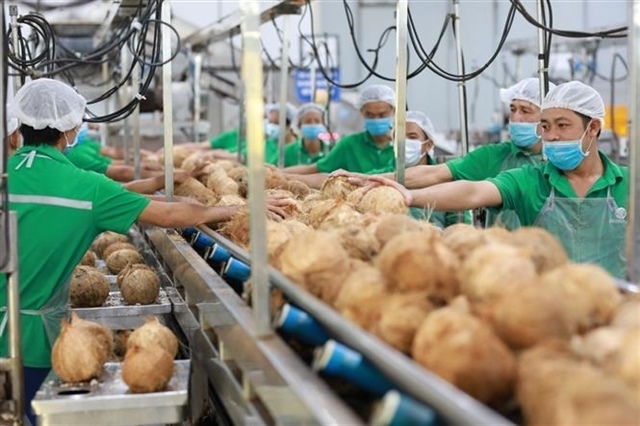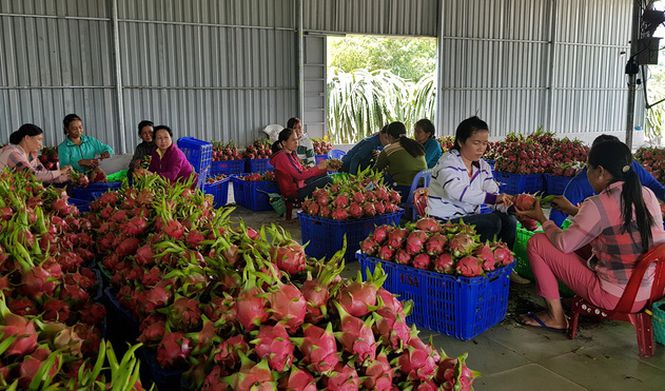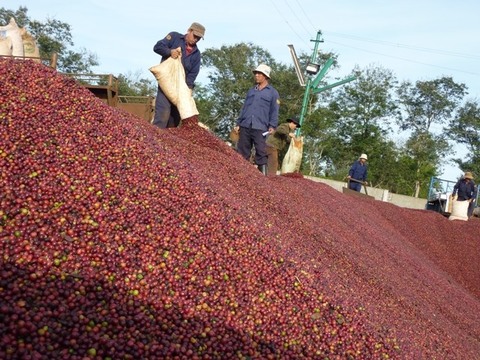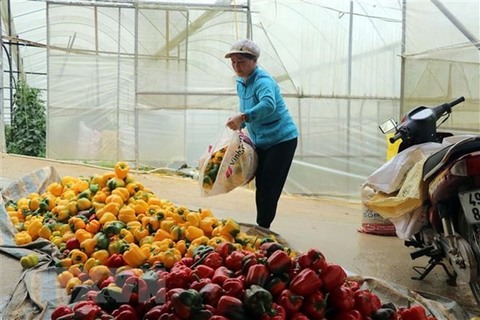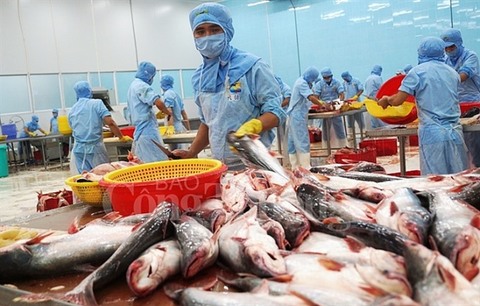Landslide changes in phone segment
Landslide changes in phone segment
As Vietnamese smartphone producers are launching new products and Chinese giants are stepping up their game, Samsung and Apple’s hold on the market seems more fragile than ever before.
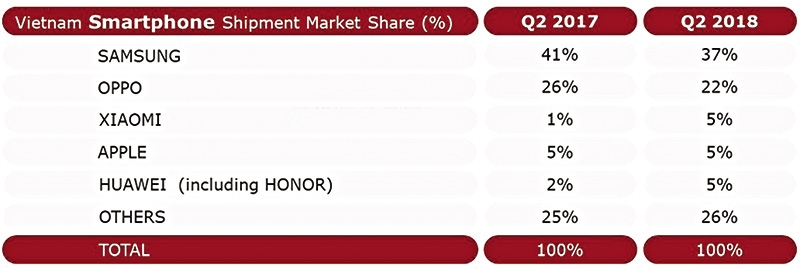
Local brands flex muscles
Last week, Bkav Corporation officially launched Bphone 3, expecting that the new version will bring it closer to becoming the best-selling mobile phone brand in Vietnam. “Bkav has 10 years to prepare and realise this ambition. If mobile phone producers hold perfect technology, they can overcome competitors to gain the first position. Apple and Samsung succeeded this way, thus, with our existing technology basis, Bkav is confident in gaining the No.1 position,” said Nguyen Tu Quang, CEO of Bkav.
Learning from failed debuts, Bkav will revolutionise the distribution of Bphone 3. Instead of putting it on sale on e-commerce sites or on the shelves of electronics retailer Mobile World, Bkav will establish a store chain by co-operating with the Bphone Fan Club and the Bkav Pro collaborators network. In its plan with the timeline having not been disclosed, Bkav will open 300 stores in cities and provinces across the country. In Hanoi and Ho Chi Minh City, there will be at least one Bphone store in each district.
Another contender from Vietnam, Vingroup has recently set up Vinsmart with $131 million to produce smart electronics, starting with the Vsmart smartphone brand. Just three weeks after the announcement, Vinsmart and the leading pish technology firm BQ signed a strategic partnership to ensure that the production of Vsmart will be in accordance with international standards.
Accordingly, Vinsmart will purchase intellectual property rights from BQ to develop two Vsmart models for the high-end and mid-range markets. In addition, Vinsmart will exploit BQ’s strengths across the entire process, from design through research and development to production. This is an important step for Vinsmart to soon launch its smartphones with futuristic design and European-standard technology as BQ is currently co-operating with many prestigious technology partners from around the world, such as Qualcomm, Google, and several pish universities to research and develop products and deploy production.
“We are working with the world’s leading companies, seeking out the best experts and completing the production line,” said Nguyen Mai Hoa, general director of Vinsmart.
Influx of foreign names
In addition to the movements of Vietnamese mobile phone makers, foreign brands have also been stepping up their game. In the end of September, Nokia announced a return to Vietnam by signing a strategic partnership with Digiworld, beginning to distribute Nokia smartphones from the second half of 2018’s fourth quarter. However, DGW is not the exclusive distributor of Nokia in Vietnam, as HMD Global Oy, the producer of Nokia products, has also entered into a co-operation with at least another distributor, FPT Trading. Switching to Android from the Windows operation system is one of the reasons that Digiworld and HMD believe that Nokia could return to its glory times in Vietnam.
Talking with VIR about the “rebirth,” a Digiworld representative said that Nokia will improve its old phone lines with new features to suit the modern demand. It is targeting the mid-tier segment and avid Nokia fans and millennials.
However, according to an expert, there is a veritable flood of emerging brands offering competitive quality at cheaper prices. Moreover, most young customers and teenagers know little about Nokia, which will make it difficult for Nokia.
Indeed, Chinese producers like Oppo, Huawei, and Xiaomi are also trying to gain market share in Vietnam. In August, Huawei, the world’s second largest mobile phone manufacturer, officially launched its first store in Hanoi presenting hi-tech Huawei smartphones, tablets, laptops, smart watches, and other IoT products, confirming its ambition to become the second best-selling phone brand in Vietnam by 2020.
“The store launch is just our first step, we have already built a long-term strategy for Vietnam. In the time coming, Huawei will continue opening more stores across the country,” said Henry Liu, director of CBG Huawei Vietnam.
The smartphone market is expected to remain heated, especially in the mid-tier. According to Counterpoint Technology Market Research, Oppo sold the second highest number of smartphones in the second quarter of this year (around 22 per cent of the market), followed by Huawei and Xiaomi (combined 10 per cent).
Tarun Pathak, associate director of Counterpoint, said: “The growth of Chinese players at the expense of local players is a key trend across emerging markets and Vietnam is no exception. This is due to the fact that the average selling price of smartphones increases every year. Users in emerging markets are upgrading to smartphones in higher price brackets than their previous purchase. While first-time smartphone users are targeted by local players, the users who are buying their second or third smartphones are in the sweet spot of Chinese smartphone players who have robust portfolios above $100.”
The race heats up
With the price of VND5-10 million ($220-440) as well as eye-catching marketing strategies, Chinese smartphones have quickly gained a foothold in Vietnam by targeting young people who want new technologies, take photos, and surf social networks – on a budget.
Two years ago, in May 2016, the third and fourth ranks were held by Mobiistar (5.8 per cent) and Microsoft (4.7 per cent), while the runners-up were Sony (4.6 per cent) and Taiwan-based HTC and Asus (2 per cent each). However, by now, these brands have been replaced by Chinese mobile manufacturers, and Sony and Microsoft even withdrew.
According to the latest statistics of Counterpoint, in the second quarter of this year, the local smartphone market grew by 11 per cent on-year, the highest since the fourth quarter of 2016. Growth was due to new launches and offers in the entry to mid segment, mainly from Chinese brands. Of these, Xiaomi is the fastest growing brand, going from 1 per cent in the second quarter of last year to 5 per cent of the total shipment market in the same period this year.
Xiaomi entered the top five in Vietnam for the first time, owing to the strong performance of Redmi 5A and Note 5. Similarly, Huawei’s market share increased from 2 to 5 per cent, producing a 193 per cent growth rate. Meanwhile, the shipment market share of Samsung decreased from 41 to 37 per cent between the second quarters of 2017 and 2018. Despite a decrease of 4 per cent to 22 per cent, Oppo still remains the second largest brand.
According to Pathak from Counterpoint, Chinese players are already pressuring global brands like Samsung and Apple in Vietnam. “That is the reason why we expect both Samsung and Apple to get aggressive in the market to retain hold of the growing mid-tier smartphone demand. The recent opening of a premium Apple reseller store and Samsung’s increasing investment into manufacturing both point in this direction,” he told VIR, adding that the US-China trade war will weaken the yuan, resulting in cheaper Chinese products. This will help Chinese brands, which now hold around 39 per cent of the market in Vietnam, helping to grind down the dominance of Samsung and Apple.





